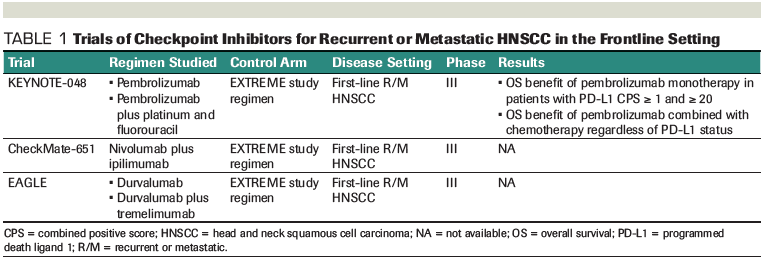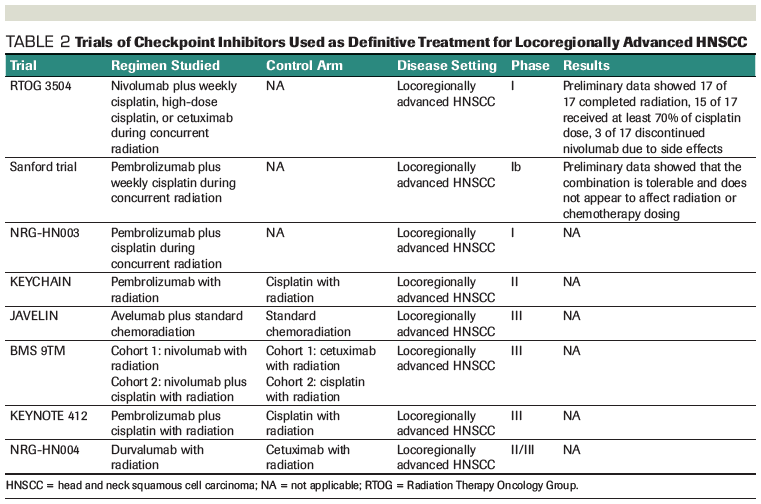Immunotherapeutic Approaches to the Management of Head and Neck Cancer
Experts discuss the PD-1 checkpoint inhibitors nivolumab and pembrolizumab in the management of head and neck cancer, and how to choose between them.
Oncology (Williston Park). 32(12):617-9, 625-6.

Xinyu Nan, MD

Kathryn A. Gold, MD

Ezra Cohen, MD

Table 1. Trials of Checkpoint Inhibitors for Recurrent or Metastatic HNSCC in the Frontline Setting

Table 2. Trials of Checkpoint Inhibitors Used as Definitive Treatment for Locoregionally Advanced HNSCC

The two programmed death 1 checkpoint inhibitors nivolumab and pembrolizumab are approved by the US Food and Drug Administration as second-line treatment for recurrent or metastatic head and neck squamous cell carcinoma (HNSCC). Based on the existing data, the effectiveness of these two drugs is similar in this setting. When choosing between them, the decision should be individualized and can be determined by patient and provider preferences, as well as scheduling. Testing for tumor programmed death ligand 1 (PD-L1) and human papillomavirus status is not required for use of these checkpoint inhibitors in the second-line setting, but the level of tumor PD-L1 expression can be useful for decision making in special situations. There are many ongoing trials that are studying immunotherapy as frontline treatment for recurrent or metastatic HNSCC, as well as trials combining immunotherapy with definitive chemoradiation in locally advanced disease. Based on the updated results of the KEYNOTE-048 trial, checkpoint inhibitors will likely be a part of first-line therapy in the near future.
The standard frontline treatment for patients with recurrent or metastatic head and neck squamous cell carcinoma (HNSCC) is platinum-based chemotherapy with fluorouracil (5-FU) and cetuximab. This regimen was tested in the phase III EXTREME trial, which demonstrated significantly longer median overall survival (from 7.4 months to 10.1 months) and progression-free survival (from 3.3 months to 5.6 months).[1] Immunotherapy with checkpoint inhibitors has activity in head and neck cancer, and the programmed death 1 (PD-1) inhibitors nivolumab and pembrolizumab have both been approved by the US Food and Drug Administration (FDA) for patients with platinum-refractory disease. In general, tumors are considered platinum refractory if disease progression occurs within 6 months of the last dose of platinum-based therapy administered as part of definitive therapy, or if disease progression occurs following a platinum-containing regimen for recurrent or metastatic disease.
Both nivolumab and pembrolizumab have demonstrated superiority over standard single-agent systemic chemotherapy in phase III randomized controlled trials. In the CheckMate 141 study, the median overall survival was significantly longer (7.5 months vs 5.1 months) in the nivolumab group compared with the group that received investigator's choice of therapy (methotrexate, docetaxel, or cetuximab).[2] Treatment with pembrolizumab showed a clinically meaningful improvement in survival over chemotherapy (8.4 months vs 6.9 months) in the KEYNOTE-040 trial.[3] In fact, the survival rates seen between the two trials were relatively similar. Furthermore, the objective response rates of these two PD-1 inhibitors were also similar between the trials (13.3% for nivolumab and 14.6% for pembrolizumab).[2,3] Although no studies have directly compared nivolumab and pembrolizumab, we and many other clinicians believe the two drugs have similar activity, efficacy, and toxicity. Patient and provider preference and scheduling issues (nivolumab is available as q 2 week and q 4 week dosing, pembrolizumab is available as q 3 week dosing) should be considered when choosing between the two drugs.
When initiating nivolumab or pembrolizumab as second-line therapy for patients with recurrent or metastatic HNSCC, testing for tumor programmed death ligand 1 (PD-L1) status is not required. Most of the major trials have demonstrated the benefit of using a PD-1 inhibitor regardless of tumor PD-L1 expression levels. In the CheckMate 141 study, the median overall survival of patients with tumor PD-L1 expression ≥ 1% was 8.7 months in the nivolumab group and 4.6 months with single-agent chemotherapy (hazard ratio [HR], 0.55). For patients with less than 1% tumor PD-L1 expression, median survival was similar between the immunotherapy and chemotherapy arms (5.7 months vs 5.8 months; HR, 0.89), and nivolumab was generally better tolerated.[2] However, the 2-year follow-up data from CheckMate 141 showed longer median survival for the patients with less than 1% tumor PD-L1 expression in the nivolumab group (6.5 months vs 5.5 months) compared with the single-agent chemotherapy group, with a lower HR (0.73).[4] It should be noted that the assessment of PD-L1 expression in this trial was performed on patients' tumor cells only. The benefit observed in PD-L1-negative patients could be due to PD-L1 expression in stromal cells. Although there is no clear survival advantage when PD-L1 expression is negative, we still think using nivolumab is beneficial in this setting, given that it is less toxic and provides a longer duration of response compared with single-agent chemotherapy. In addition, these data tell us that positive tumor PD-L1 expression predicts for greater magnitude of benefit with nivolumab.
Similar results were demonstrated in the phase II KEYNOTE-055[5] and phase III KEYNOTE-040[3] trials, in which both PD-L1-positive and PD-L1-negative groups showed benefit with pembrolizumab. Both studies showed that a higher PD-L1 combined positive score (CPS) predicts for a higher response rate with pembrolizumab.[3,5] Therefore, currently, we believe that tumor PD-L1 status is not required to be tested for use of checkpoint inhibitors in the second-line setting, but it can be helpful with decision making for patients in special situations. One example of such a situation is in patients with higher than average risk for toxicity with checkpoint inhibition. It can also be useful when making decisions for patients who are qualified for first-line platinum-containing chemotherapy regimens, such as the EXTREME regimen, but who may not be able to tolerate the therapy (eg, those with poor performance status, old age, and/or comorbidities, etc). In these settings, high tumor PD-L1 expression may more strongly indicate for the use of checkpoint inhibitors as an alternative option. However, it should be noted that regardless of PD-L1 status, neither pembrolizumab nor nivolumab is FDA approved for the first-line treatment of recurrent or metastatic HNSCC, and are considered off-label.
Human papillomavirus (HPV) status is an important prognostic marker for oropharyngeal squamous cell carcinoma. In the majority of recurrent or metastatic HNSCC immunotherapy trials, p16 immunohistochemical testing is used to assess HPV status in patients with oropharyngeal cancer. In the CheckMate 141 study, approximately 50% of the patients had p16 status reported, and suggested that both p16-positive and p16-negative patients benefited from nivolumab. For p16-positive patients, the median overall survival was significantly longer in the nivolumab group (9.1 months) vs single-agent chemotherapy (4.4 months). For p16-negative patients, the overall survival was also longer in the nivolumab group compared with the single-agent chemotherapy group (7.5 months vs 5.8 months), but was not statistically significant.[2] The magnitude of benefit appears to be larger among p16-positive patients in this study. However, there are inconsistent results among other studies and when directly comparing the response rates between p16-positive and p16-negative groups. In a subgroup analysis of the KEYNOTE-040 trial, the HR for overall survival was lower in the p16-negative group compared with the p16-positive group.[3] In the phase II KEYNOTE-055 study, the response rate to pembrolizumab between p16-positive and p16-negative patients was similar (16% vs 15%).[5] However, in the phase Ib KEYNOTE-012 trial, the response rate was significantly different, at 32% vs 14% among those with HPV-associated and non-HPV-associated disease.[6] Overall, we believe there are no clear differences between response in p16-positive and p16-negative patients, and it should not be a factor in selecting therapy.
There are three ongoing trials studying the use of checkpoint inhibitors for recurrent or metastatic HNSCC in the frontline setting (Table 1). KEYNOTE-048 is a phase III study comparing pembrolizumab monotherapy vs the current standard of care, the EXTREME study regimen, and vs pembrolizumab in combination with platinum and 5-FU chemotherapy as first-line therapy.[7] The results of this study were presented at the European Society for Medical Oncology (ESMO) 2018 Congress and showed that pembrolizumab monotherapy had met the primary endpoint of overall survival in patients whose tumor PD-L1 CPS was ≥ 1 and ≥ 20. Based on these updated data, the pembrolizumab monotherapy group had significantly longer overall survival compared with the EXTREME study regimen group (12.3 months vs 10.3 months for the PD-L1 CPS ≥ 1 population and 14.9 months vs 10.7 months for the PD-L1 CPS ≥ 20 population). Although response rate was lower in the pembrolizumab monotherapy group, the duration of response was substantially longer compared with the EXTREME study regimen (20.9 months vs 4.5 months in the PD-L1 CPS ≥ 1 population and 20.9 months vs 4.2 months in the PD-L1 CPS ≥ 20 population).[7] In addition, there was a significantly lower incidence of adverse effects (all grade adverse events, 58.3% vs 96.9%; grade 3-5 adverse events, 16.7% vs 69%) with pembrolizumab monotherapy compared with the EXTREME regimen.[7]
The updated data also suggest that overall survival in the group that received pembrolizumab with chemotherapy was significantly longer than the group that received the EXTREME study regimen, regardless of PD-L1 status (13.0 months vs 10.7 months). The safety profile was similar between these two regimens.[7] Based on these data, we believe that pembrolizumab monotherapy will become the new standard first-line treatment for recurrent and metastatic HNSCC with PD-L1 CPS > 1, and that pembrolizumab combined with platinum and 5-FU chemotherapy will become the new first-line treatment for recurrent and metastatic HNSCC with negative or unknown PD-L1 status, or for patients who require urgent response.
Conor Steuer, MD
Why Immunotherapy Will Become the New Standard of Care in HNSCC
The treatment of head and neck squamous cell carcinoma (HNSCC) is a rapidly evolving landscape. The article by Nan et al describes the impressive advances in immuno-oncology in HNSCC, specifically with checkpoint inhibitors in the recurrent/metastatic setting. The recent US Food and Drug Administration approval of nivolumab and pembrolizumab in platinum-exposed patients, based on improved survival compared with chemotherapy, has opened the door for the use of these agents in a variety of clinical settings.
Importantly, data reported at the European Society for Medical Oncology (ESMO) 2018 Congress on the results of KEYNOTE-048 confirmed the significant activity of programmed death 1 (PD-1) inhibitors in the first-line recurrent or metastatic HNSCC setting. This phase III randomized trial compared the standard-of-care EXTREME study regimen (platinum-containing chemotherapy with fluorouracil [5-FU] plus cetuximab) vs pembrolizumab monotherapy and the combination of chemotherapy plus pembrolizumab. The primary endpoints were progression-free survival (PFS) and overall survival (OS) in patients with a programmed death ligand 1 (PD-L1) combined positive score (CPS) ≥ 1 and a CPS ≥ 20. Most importantly, for patients with PD-L1 CPS ≥ 1, pembrolizumab monotherapy had significantly improved OS over standard chemotherapy. The improved OS was most pronounced in the patients with PD-L1 CPS ≥ 20 (hazard ratio [HR], 0.61; 95% CI, 0.45-0.83; P = .0007). The pembrolizumab/ chemotherapy arm also demonstrated improved survival over the EXTREME regimen in all patients (HR, 0.77; 95% CI, 0.63-0.93; P = .0034). There was no significant difference in overall response rate or PFS seen and, as expected, pembrolizumab monotherapy was better tolerated than the EXTREME regimen.
This study has led the way for pembrolizumab to be the new standard of care for the upfront treatment of recurrent/metastatic HNSCC. Given the improvement in OS noted in KEYNOTE-048 and the toxicity and logistical challenges of the EXTREME regimen, this represents a significant step forward in the first-line recurrent/metastatic space. However, as important as these findings are, clinicians and researchers need to continue to strive to better understand the biology of the disease and develop treatments that target the vast majority of patients who still succumb to this disease. Fortunately, there are multiple ongoing studies incorporating immunotherapy in earlier-stage disease, examining the activity of drugs focused on various immune pathways, novel combinations, and targeted therapies. Overall, these recent findings are translating into a significant benefit for HNSCC patients.
Financial Disclosure: Dr. Steuer is a speaker for Merck and serves on the advisory boards for AbbVie, ARMO Biosciences, and BerGenBio.
Dr. Steuer is an Assistant Professor in the Department of Hematology and Medical Oncology at Winship Cancer Institute of Emory University in Atlanta, Georgia.
The CheckMate 651 trial is another phase III trial that is studying nivolumab in combination with ipilimumab compared with the standard of care (EXTREME study regimen) as first-line treatment for patients with recurrent or metastatic HNSCC.[8] They are in the process of accruing patients, and no preliminary results are available at this point. There is also an ongoing phase III trial (the EAGLE trial) testing durvalumab alone and in combination with tremelimumab vs the standard of care (ClinicalTrials.gov identifier: NCT02369874). Durvalumab is a PD-L1 inhibitor that has shown clinical activity in a phase II study.[9] Tremelimumab is a human monoclonal antibody against cytotoxic T-lymphocyte-associated antigen 4 (CTLA-4). The results of this study are still pending. We believe that these three trials have a high likelihood of changing the standard of care for the frontline management of recurrent or metastatic HNSCC. Checkpoint inhibitors will likely be a part of the new first-line therapy in the near future.
There are also ongoing trials to incorporate checkpoint inhibitors into definitive treatment for locoregionally advanced HNSCC (Table 2). The first study to test the safety of this approach was a phase Ib trial that combined pembrolizumab with weekly cisplatin and concurrent radiation therapy for stage III to IVB HNSCC. Preliminary results of this trial showed that the combination is tolerable and does not appear to affect radiation or chemotherapy dosing.[10] The Radiation Therapy Oncology Group (RTOG) 3504 trial is a phase I trial that is studying the safety and toxicity of nivolumab combined with weekly cisplatin, high-dose cisplatin, or cetuximab during concurrent radiation therapy.[11] NRG-HN003 is another phase I trial that will determine the optimal dosing of pembrolizumab when combined with cisplatin and radiation therapy for high-risk stage III to IV HNSCC (ClinicalTrials.gov identifier: NCT02775812). JAVELIN is a phase III trial that is testing avelumab (a human IgG1 monoclonal antibody against PD-L1) together with standard chemoradiation therapy (CRT) compared with CRT alone in high-risk locally advanced HNSCC.[12] Final results from these trials are not yet available.
In addition, there are several ongoing phase II and III trials studying nivolumab, pembrolizumab, and durvalumab combined with radiation or chemoradiation as definitive treatment for locoregionally advanced HNSCC (Table 2). Most of the trials are early stage and have no preliminary results, so we cannot draw any conclusions on the effectiveness of immunotherapy in this setting. However, several preclinical studies have already shown the synergistic effects of combining immunotherapy with radiotherapy for both local and distant tumor control.[13] Therefore, using this approach could potentially improve the current standard of care for locally advanced HNSCC.
In summary, immunotherapy has an important role in the treatment of head and neck cancer. Nivolumab and pembrolizumab are now the standard of care in the second-line treatment of recurrent or metastatic HNSCC. Both drugs have similar efficacy and toxicity in this setting. Therefore, the choice between the two should be based on provider and patient preference. Testing for tumor PD-L1 and HPV status is not required when initiating treatment with nivolumab or pembrolizumab, but higher tumor PD-L1 expression levels predict for greater magnitude of benefit. There are also many ongoing trials studying immunotherapy in the frontline setting for recurrent or metastatic HNSCC and combined with definitive chemoradiation in locally advanced disease. Based on some preliminary results, immunotherapy has the potential to be part of the first-line treatment for recurrent or metastatic HNSCC in the near future.
Financial Disclosure: Dr. Cohen has an advisory role with Amgen, AstraZeneca, Bristol-Myers Squibb, EMD Serono, Incyte, Merck, and Pfizer. The other authors have no significant financial interest in or other relationship with the manufacturer of any product or provider of any service mentioned in this article.
References:
1. Vermorken JB, Mesia R, Rivera F, et al. Platinum-based chemotherapy plus cetuximab in head and neck cancer. N Engl J Med. 2008;359:1116-27.
2. Ferris RL, Blumenschein G, Fayette J, et al. Nivolumab for recurrent squamous-cell carcinoma of the head and neck. N Engl J Med. 2016;375:1856-67.
3. Soulieres D, Cohen E, Le Tourneau C, et al. Updated survival results of the KEYNOTE-040 study of pembrolizumab vs standard-of-care chemotherapy for recurrent or metastatic head and neck squamous cell carcinoma. Presented at the American Association for Cancer Research Annual Meeting; Apr 14-18, 2018; Chicago, IL. Abstract CT115.
4. Ferris RL, Blumenschein G, Fayette J, et al. Nivolumab vs investigator's choice in recurrent or metastatic squamous cell carcinoma of the head and neck: 2-year long-term survival update of CheckMate 141 with analyses by tumor PD-L1 expression. Oral Oncol. 2018;81:45-51.
5. Bauml J, Seiwert TY, Pfister DG, et al. Pembrolizumab for platinum- and cetuximab-refractory head and neck cancer: results from a single-arm, phase II study. J Clin Oncol. 2017;35:1542-9.
6. Chow LQM, Haddad R, Gupta S, et al. Antitumor activity of pembrolizumab in biomarker-unselected patients with recurrent and/or metastatic head and neck squamous cell carcinoma: results from the phase Ib KEYNOTE-012 expansion cohort. J Clin Oncol. 2016;34:3838-45.
7. Burtness B, Harrington KJ, Greil R, et al. KEYNOTE-048: phase 3 study of first-line pembrolizumab (P) for recurrent/metastatic head and neck squamous cell carcinoma (R/M HNSCC). Presented at the European Society for Medical Oncology 2018 Congress; October 19-23, 2018; Munich, Germany. Abstract LBA8_PR.
8. Argiris A, Gillison M, Ferris RL, et al. A randomized, open-label, phase 3 study of nivolumab in combination with ipilimumab vs extreme regimen (cetuximab + cisplatin/carboplatin + fluorouracil) as first-line therapy in patients with recurrent or metastatic squamous cell carcinoma of the head and neck-CheckMate 651. Ann Oncol. 2016;27(suppl 6):328-50.
9. Zandberg D, Algazi A, Jimeno A, et al. Durvalumab for recurrent/metastatic head and neck squamous cell carcinoma: preliminary results from a single-arm, phase 2 study. Presented at the European Society for Medical Oncology 2017 Congress; September 8-12, 2017; Madrid, Spain. Abstract 1042O.
10. Powell SF, Gitau MM, Sumey CJ, et al. Safety of pembrolizumab with chemoradiation (CRT) in locally advanced squamous cell carcinoma of head and neck (LA-SCCHN). J Clin Oncol. 2017;35(suppl):abstr 6011.
11. Gillison ML, Ferris RL, Zhang Q, et al. A randomized phase II study of chemoradiation (CRT) +/- nivolumab (Nivo) with sequential safety evaluations of Nivo +/- lirilumab (Liri) or ipilumumab (Ipi) concomitant with (C) RT in intermediate (IR) and high-risk (HR) head and neck squamous cell carcinoma (HNSCC) (RTOG 3504, NCT02764593). J Clin Oncol. 2017;35(suppl):abstr TPS6097.
12. Lee NY, Ferris RL, Beck JT, et al. JAVELIN head and neck 100: A phase 3 trial of avelumab in combination with chemoradiotherapy (CRT) vs CRT for 1st-line treatment of locally advanced squamous cell carcinoma of the head and neck (LA SCCHN). J Clin Oncol. 2017;35(suppl):abstr TPS6093.
13. Chajon, E, Castelli J, Marsiglia H, et al. The synergistic effect of radiotherapy and immunotherapy: a promising but not simple partnership. Oncol Hematol. 2017;111:124-32.
Late Hepatic Recurrence From Granulosa Cell Tumor: A Case Report
Granulosa cell tumors exhibit late recurrence and rare hepatic metastasis, emphasizing the need for lifelong surveillance in affected patients.